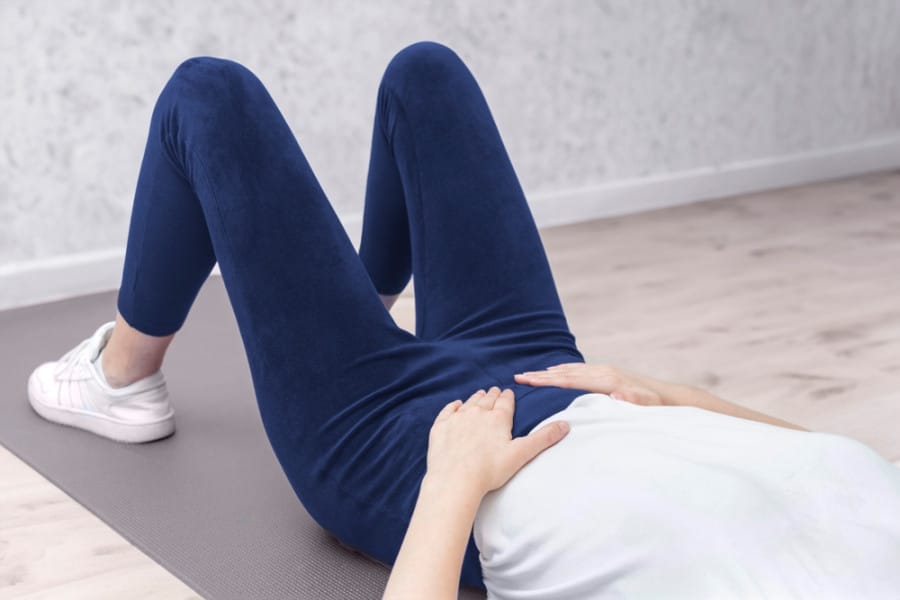These Pelvic Floor Exercises After Giving Birth Can Help Prevent Leaking, Prolapse, And Pain
Pregnancy can bring about numerous changes in the body, such as unexpected swelling, balance issues, sleep troubles, and pelvic floor discomfort. While these symptoms usually fade after giving birth, it is essential to prioritize the strength of your pelvic floor during pregnancy and recovery. This highlights the significance of postpartum pelvic floor exercises.
Marcy Crouch, a DPT, emphasizes the importance of these exercises in reducing leaking, pain, and prolapse in women postpartum. The pelvic floor muscles, which support the pelvic organs, undergo significant strain during pregnancy and childbirth and require proper rehabilitation. Similar to other muscles, the pelvic floor can be conditioned and strengthened.
The benefits of doing postpartum pelvic floor exercises
Most women are cleared for sex and exercise at six weeks postpartum, but certain exercises, including breathwork, can be initiated earlier.
Jami Wilson, a pelvic floor physical therapist, recommends starting with rest for the first few days postpartum and gradually incorporating breathwork to engage the diaphragm and abdominal muscles. Pelvic floor exercises can aid recovery and address any pelvic floor dysfunction developed during pregnancy, such as painful sex, pelvic pain, incontinence, or pelvic organ prolapse.
If experiencing discomfort, a pelvic floor physical therapist can assess your pelvic floor strength and function and guide you in retraining and reinforcing these muscles.
Dr. Crouch emphasizes that when these muscles are not functioning properly, it can lead to pain, incontinence, pelvic organ prolapse, constipation, sexual dysfunction, and other issues, underscoring that strength is only one aspect of their function.
Once cleared for exercise, gradually integrating pelvic floor work into your routine can help reengage core muscles that have been dormant for months.
To assist women in incorporating pelvic floor exercises into their postpartum routine, Dr. Wilson offers a list of her recommended exercises and advises gradually increasing their frequency.
6 postpartum pelvic floor exercises a physical therapist recommends
These exercises do not require equipment and can be initiated based on individual comfort levels. If experiencing any pain or discomfort, consulting a doctor or pelvic floor physical therapist is crucial.
1. Diaphragmatic breathing
Begin practicing this immediately after giving birth and continue throughout the postpartum journey. It can be performed while lying down on your back, side, or hands and knees.
Deeply breathe into the belly, down through the pelvis, and use your fingers around the lower rib cage to guide the breath. Relax the pelvic floor while inhaling and notice the slight lift on exhaling. Visualize the pelvic floor expanding with each inhale and contracting as you exhale. Maintain an even breathing pace.
Complete one set for three minutes once a day.
2. Supine heel slides
Start practicing this exercise at approximately two weeks postpartum.
While lying on your back with knees bent and feet flat on the floor, slide one leg out straight as you engage your abdominals. Ensure your body, including pelvis, glutes, and hips, remains on the floor. Alternate legs for each rep.
Do 10 reps once a day.
3. Bridge
Begin this exercise at around two weeks postpartum.
While lying on your back with knees bent and feet flat on the floor, lift your hips off the floor while engaging your pelvic floor and core. Slowly lower back down.
Repeat 10 times once a day.
4. Bird dog
Start this exercise approximately four weeks postpartum.
Begin in a hands-and-knees position, then extend one arm and the opposite leg simultaneously, ensuring stability and balance. Alternate sides for each rep.
Perform five reps once a day, four times a week.
5. Side plank with clamshell
Initiate this exercise roughly six weeks postpartum.
Start on your side, lift your hips, and open your top leg while maintaining stability.
Repeat 10 times on each side once a day, four times a week.
6. Squats
Commence this exercise at around six weeks postpartum.
Stand with feet shoulder-width apart, inhale, then lower into a squat, focusing on proper knee alignment and glute engagement.
Perform 10 reps once a day, four times a week.
Dr. Wilson suggests assessing comfort and pain levels after 10 repetitions and increasing the number of squats accordingly.














